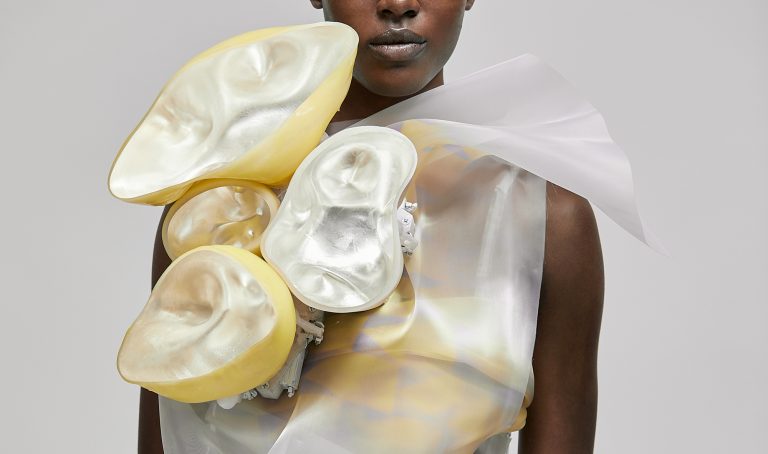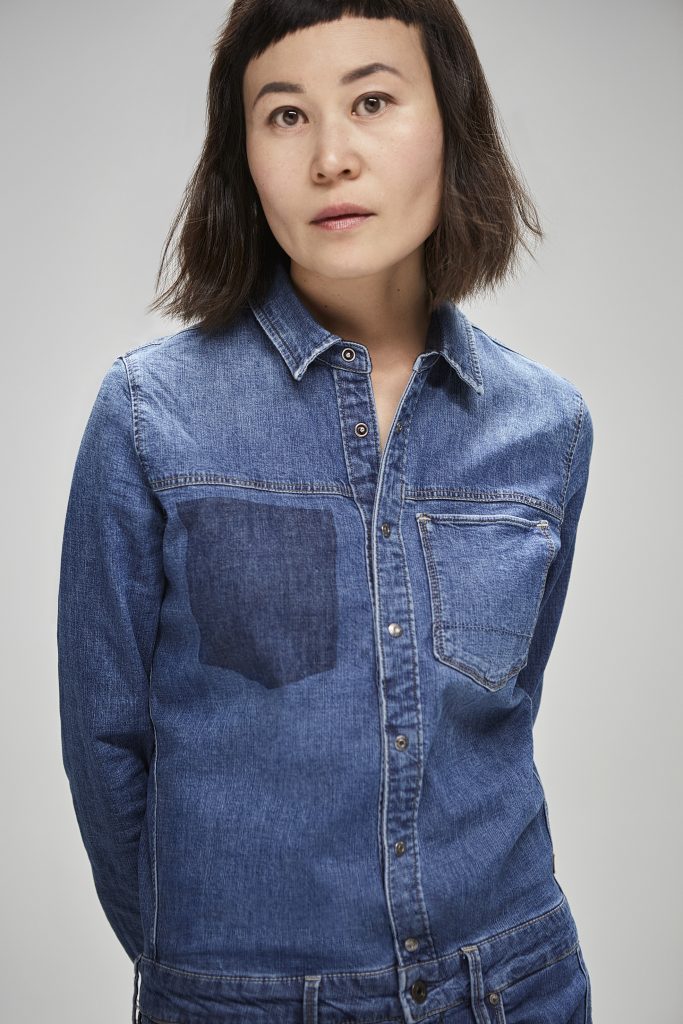
Photography by MALINA CORPADEAN
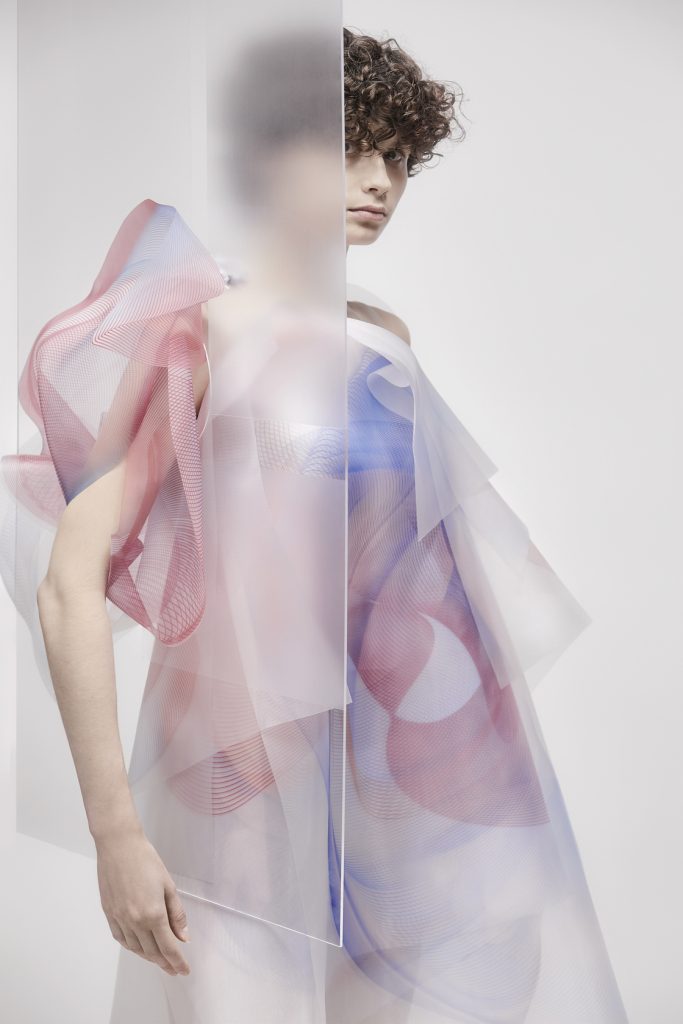
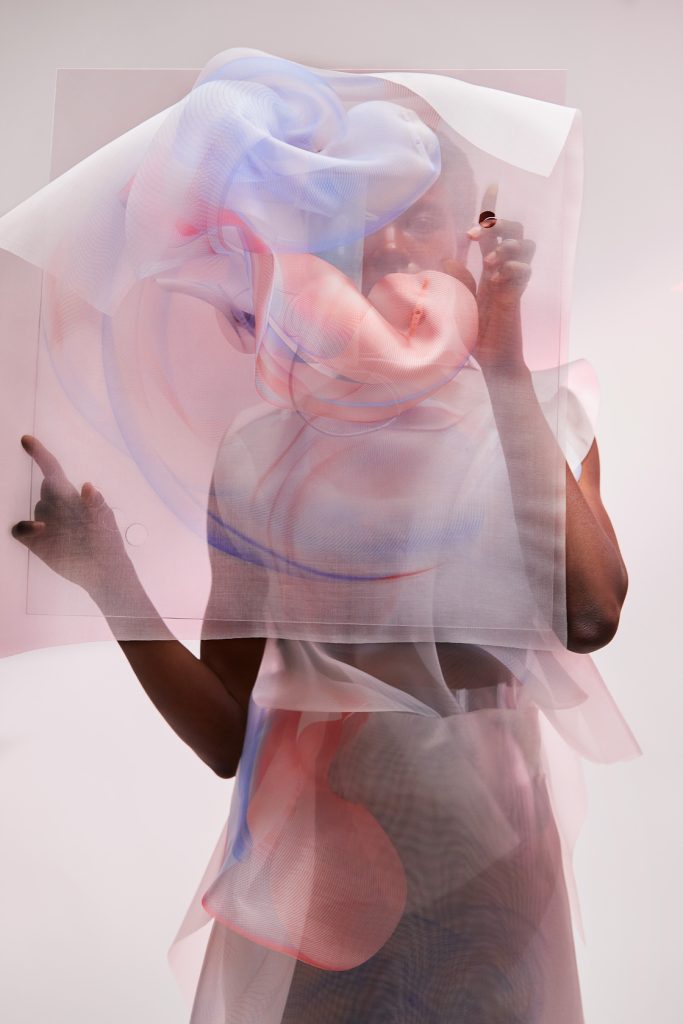
in camera
Photography by MAUDE ARSENAULT
Ying Gao‘s work transcends traditional fashion boundaries, blending elements of product design, media design and technological innovation. Discover how Ying Gao navigates the realms of the tangible and intangible, creating garments that challenge perceptions and inspire imagination.
hube: Your work sits at the intersection of fashion, product design and media design, weaving together a tapestry of innovation. What drives your exploration of these diverse creative realms and how do you navigate the fluid boundaries between them?
Ying Gao: My journey into fashion began with a fascination for its transformative power, something I discovered as a child at a Yves Saint Laurent exhibition. This early encounter with fashion’s potential to create difference inspired me to continually explore the intersections of various creative disciplines. Fashion, product design and media design each offer unique tools and perspectives that, when combined, allow for the creation of something new, and sometimes unexpected. It involves a constant dialogue between the tangible and the intangible, the physical and the digital. It’s about embracing ambiguity and using it as a catalyst for innovation.
I’d say that my exploration is driven by a desire to challenge the conventional boundaries of fashion design, to see how different disciplines can inform and enrich one another, creating a multidimensional approach to fashion. It involves constant experimentation and a willingness to embrace uncertainty.
h: Your interactive projects, such as 2526 and flowing water, standing time’, blur the lines between the physical and the digital, inviting viewers to question the nature of reality. Could you share insights into your creative process when conceptualising and bringing these visionary projects to life?
YG: The creative process for my interactive projects begins with a conceptual framework that challenges traditional perceptions of fashion design. I draw inspiration from various sources, including literature, films, the intangible elements that surround us, and human behaviour. The initial phase involves extensive research and brainstorming to develop a cohesive concept. From there, I work with my assistants to prototype and refine the designs. The process is iterative, with constant feedback and adjustments to ensure the final creation is both visually compelling and intellectually stimulating.
My creative process is rooted in the exploration of intangible elements such as air and light. These elements, full of ambiguities, provide a rich foundation for creating shapes and structures that transcend the traditional boundaries of fashion. Each project begins with a concept that often stems from a literary or philosophical idea. For example, Flowing Water, Standing Time drew inspiration from neurologist Oliver Sacks’ novel, The Man Who Mistook His Wife for a Hat. In one of the stories, 49-year-old Jimmie believes he has been 19 for decades. When confronted with a mirror, he is shocked by his aged appearance but reverts to thinking he is 19 when not viewing his reflection. Like Jimmie, the garments in this piece shift between states in reaction to the observer. I am inspired by the immaterial and attracted to everything intangible. Another book that inspired me was Esthétique de la disparition by Paul Virilio. In it, the author questions unconscious perceptions about the authenticity of images and the manipulations they often undergo. Anything that allows room for imagination compels me.
From there, I engage in extensive research and experimentation with materials and technologies, working closely with my robotics engineer Simon Laroche to bring these concepts to life. It’s a cyclical process of development, failure, and iteration.
h: 2 5 2 6 explores the concept of virtual clothing through tangible, physical garments that simulate the effects of digital fashion. What inspired this exploration and what do you hope audiences take away from encountering these surreal creations?
YG: I always try to approach the object by taking into account all the essential aspects at the design stage: substance, surface, structure, in other words, the concept, the material, the form and the finish, whereas the image tends to flatten everything out.
The inspiration for 2 5 2 6 stemmed from the growing influence of digital fashion and the desire to bridge the gap between the virtual and physical worlds. I wanted to explore how tangible garments could embody the ephemeral qualities of digital aesthetics. Through this project, I hope audiences reconsider the possibilities of fashion in a digital age. The aim is to provoke thought about the intersection of technology and materiality, and how our perception of clothing can evolve beyond traditional constraints.
If the role of the fashion designer is to imbue a form and a function to materials intended to dress the body, I wonder about the question of the immaterial garment and the virtual body, devoid of substance, when the digital has become a real ‘second nature’. As a fashion designer, images are of course important to my work, yet they also tend to flatten everything and to become unfaithful, because they are easily and readily manipulated. To animate a garment is to contradict its instrumental status as a passive prosthesis. The idea is to give voice to clothing objects, to emancipate them, to free them from a passivity they have not chosen.
h: Your work explores the fluidity of time and perception through robotic garments that react to the chromatic spectrum. How do you approach the fusion of literature, science, and design in your work, and what stories do you aim to tell through these multidimensional creations?
YG: I seek to create garments that tell stories about the human experience, our relationship with technology, and the transient nature of existence. By incorporating robotics and responsive materials, the garments become living entities that interact with their environment, thus blurring the lines between the animate and inanimate. The stories I aim to tell are about transformation, connection, and the ever-changing landscape of our reality. The fusion of literature, science and design in my work is a natural extension of my interdisciplinary approach. Literature provides a narrative framework, science offers the tools and methodologies, and design brings everything together in a tangible form. I tend to think that my garments are narrative devices that explore the complexities and ambiguities of our existence.
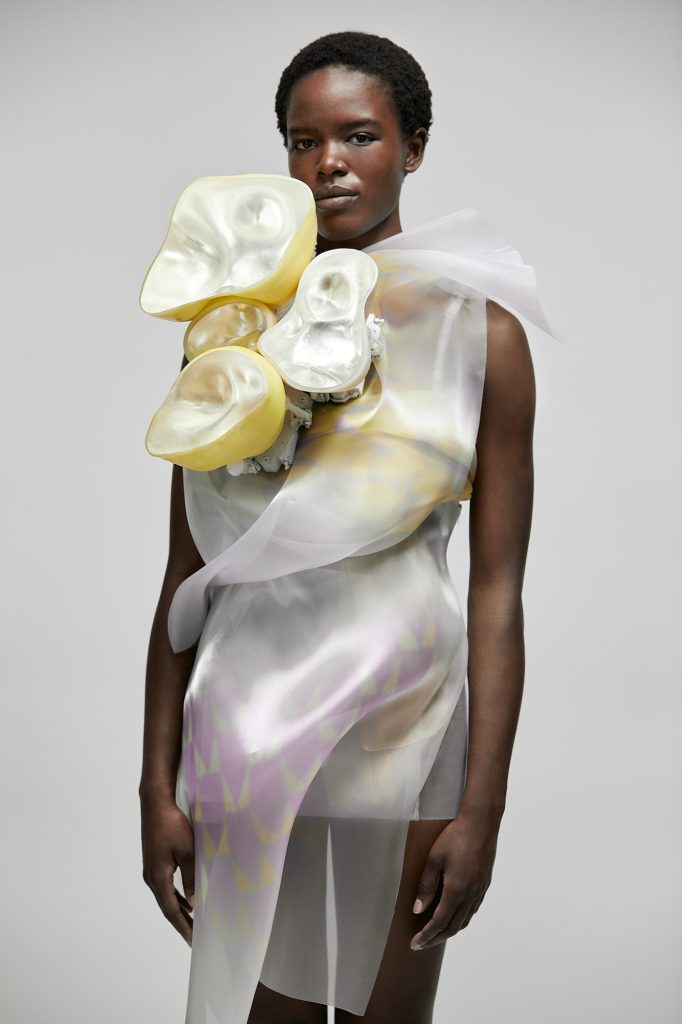
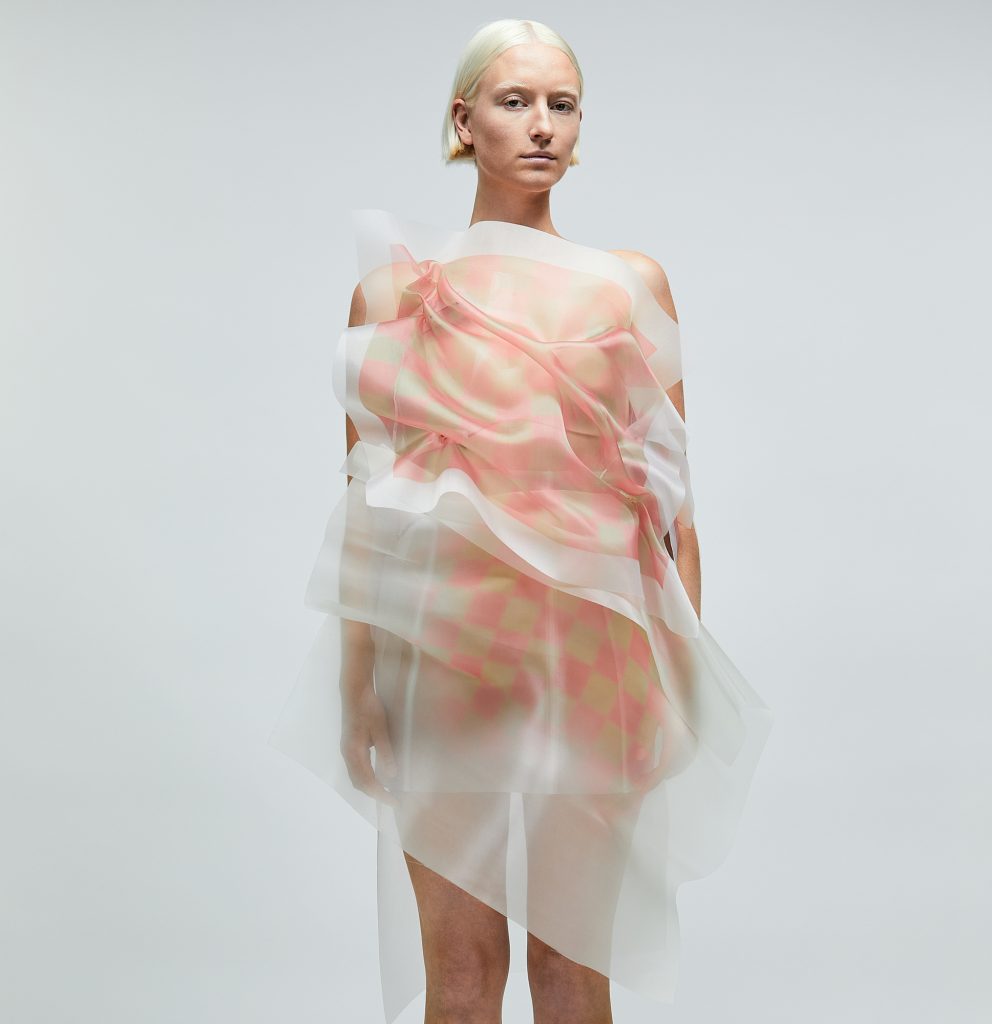
2 5 2 6
Photography by MAUDE ARSENAULT
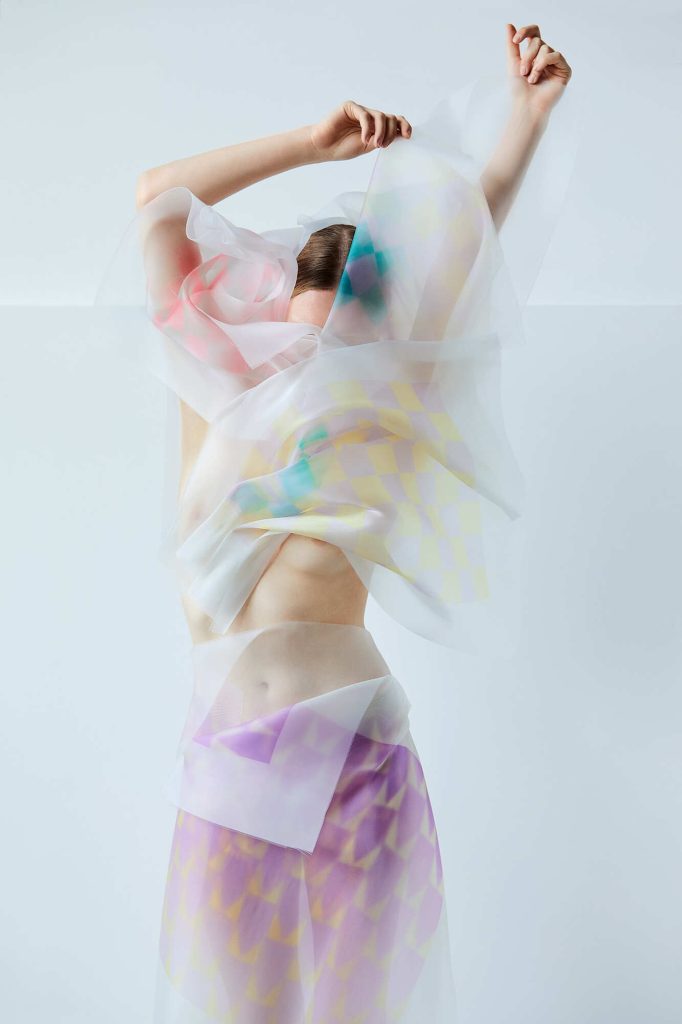
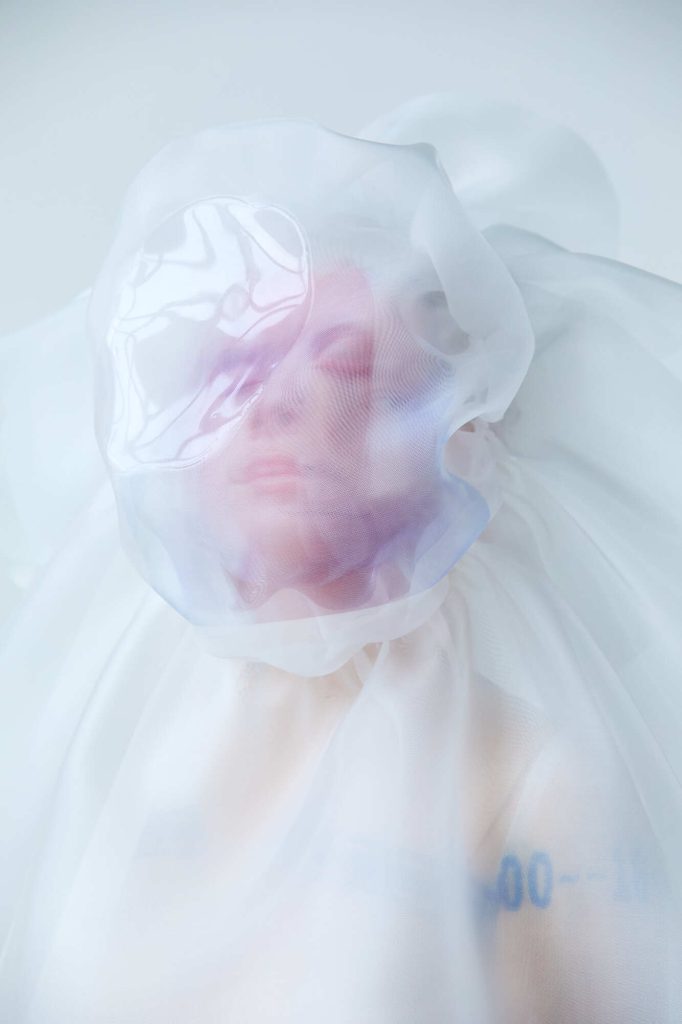
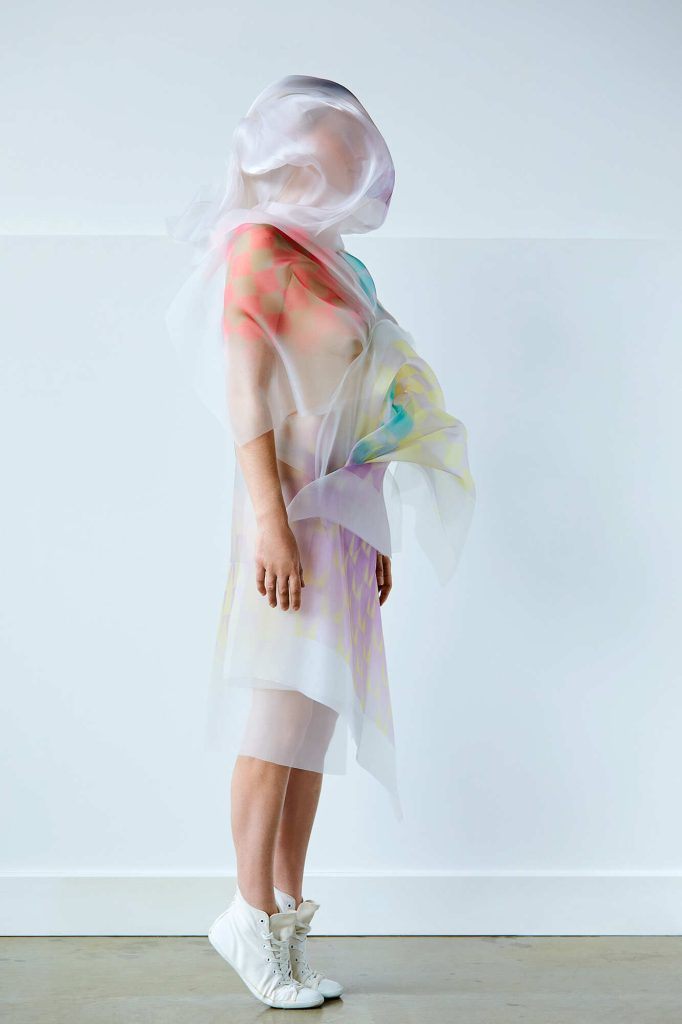
Film noir
Photography by MAUDE ARSENAULT
h: Do you believe that robotic fashion will be available for everyday wear at some point in the future? If that’s the case, could popularising it diminish its charm and distinctiveness?
YG: I do not believe that robotic fashion will be available for everyday wear in the future.
h: Your work has been exhibited worldwide and garnered international acclaim. How do you navigate the global art and fashion landscape, and what role do cultural influences play in shaping your creative vision?
YG: That’s really kind of you, I’m not sure I’ve ever really received this level of international recognition! My childhood and teenage years were spent between Switzerland and China, then I moved to Montreal when I was 19. This allowed me to navigate between different cultures, each influencing my creative vision. These cultural influences inevitably enrich my work and push me to experiment with new things.
h: As a professor at the University of Quebec in Montreal, how do you balance your role as an educator with your practice as a pioneering fashion designer? How does teaching inform your creative process and vice versa?
YG: Balancing my role as an educator with my design practice is a rewarding challenge, although I’m perpetually short on time – sometimes it feels like the day doesn’t have a full 24 hours! My workday often starts the night before, dreaming up design ideas (not very relaxing, I know). I’m constantly brainstorming, even in the middle of the night. It’s stimulating but disconnecting is tough.
Mornings begin at the university, meeting with my amazing assistants, most of whom are bachelor’s and master’s students, to plan our day. And yes, my main job is being a university professor, juggling academic duties that are essential.
Teaching allows me to share my knowledge with the next generation of designers, while also keeping me grounded. My students often bring fresh perspectives that challenge my own perception. Conversely, my design practice informs my teaching by providing real-world insights and experiences that I can share in the classroom. I hope to teach my students the importance of creating something different. Every story has already been told, but it’s the way someone tells theirs that makes the difference. Routine can be comforting, as I experience in my daily life with habits like my evening walks. However, in their work, I encourage students to express their own differences.
h: Technology plays a central role in your work, enabling garments to become poetic and interactive. How do you envision the future of fashion design in an increasingly technologically driven world, and what possibilities excite you the most?
YG: When people suggest that future garments will communicate our emotions by lighting up to show if we are happy or sad, I always respond, ‘I hope that never happens!’ Such a concept is depressing because it lacks nuance—about as subtle as a Christmas tree or a billboard. I envision my works not as mere gadgets but as thoughtfully designed objects with a conceptual and aesthetic ‘life’ that aligns with their technological purpose. Sensory technology already exists in everyday fashion in fields like extreme sports, the military, and medicine. I’m not creating science fiction. My works represent the here and now. The ideas expressed through these designs reflect the questions and uncertainties we are already facing today.
h: Your creations often carry a profound critical dimension, reflecting on societal and environmental transformations. What responsibility do you believe artists and designers have in addressing pressing global issues, and how do you incorporate this ethos into your work?
YG: Baudelaire said that beauty was a divinity with two faces: one representing the present and the other, eternity. Beauty cannot be created without uniting these two aspects: an ephemeral element and an immortal element. If fashion has an impact, if it appeals to some while displeasing others, it is undoubtedly for a single, common reason: it reminds us of the duality of the human condition – we are inevitably mortal while aspiring to eternity. So, designers have a significant responsibility in addressing global issues, as our work has the power to shape perceptions and inspire change. In my practice, I strive to incorporate themes of social critique. This is reflected in my choice of materials, the narratives I construct, and the technologies I employ. The next generation of designers not only needs to be able to sew microprocessors and sensors into clothing. Fashion design must also, and above all, reflect the more subtle uncertainties that we are already experiencing on a daily basis, which are more subtle, but at the same time more visceral.
Perhaps the future will be more human and more nuanced than what we envisage today… Perhaps it will.

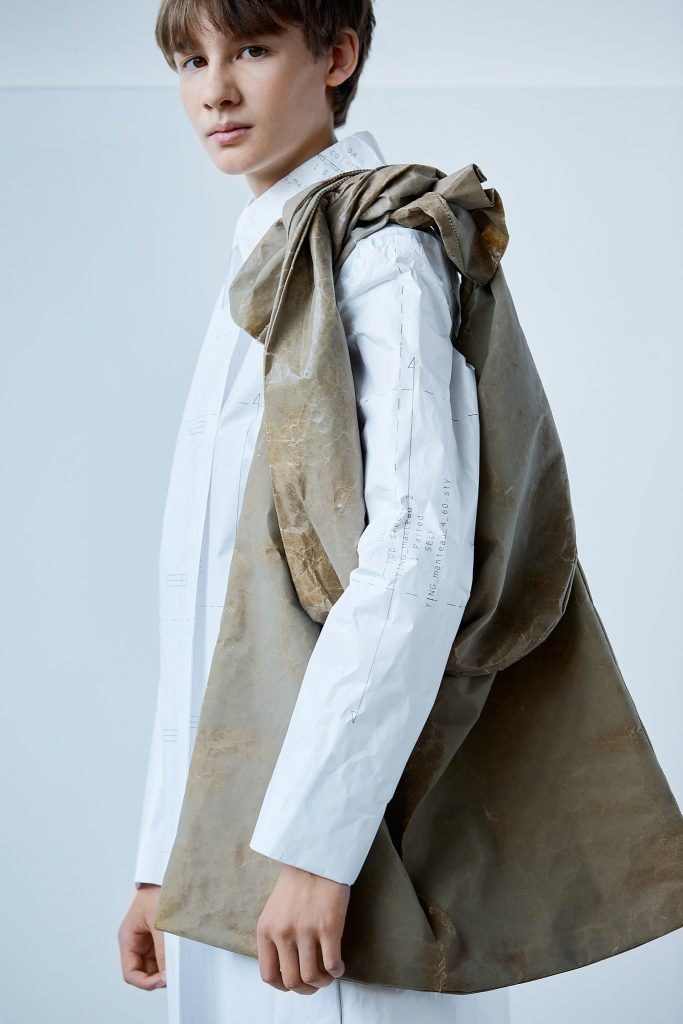
Paper work
Photography by MAUDE ARSENAULT

Paper work
Photography by MAUDE ARSENAULT
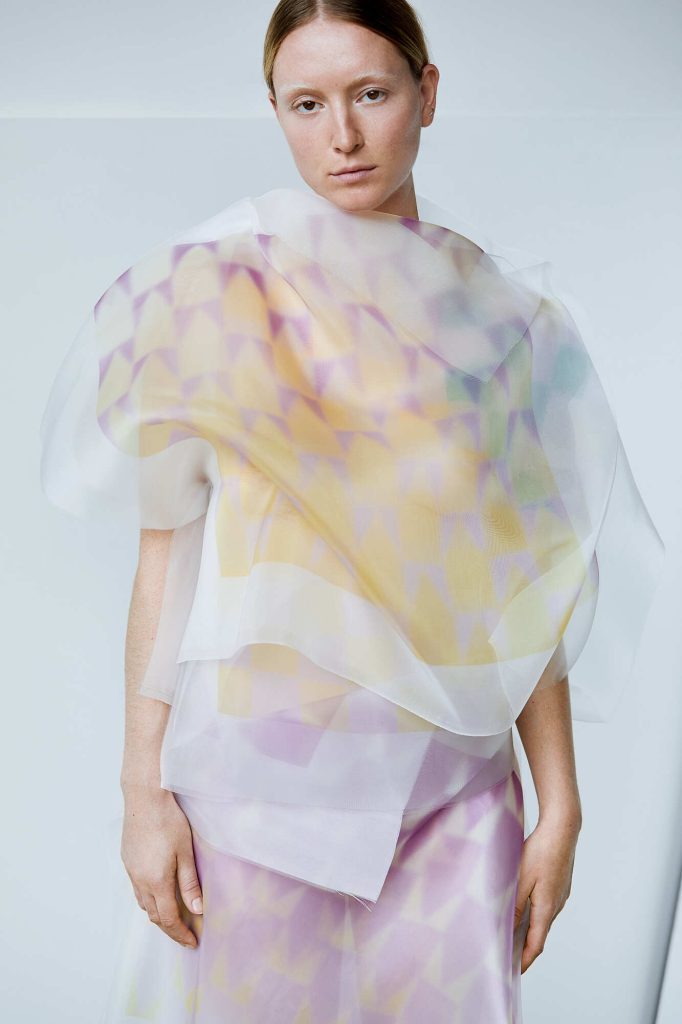
Film noir
Photography by MAUDE ARSENAULT
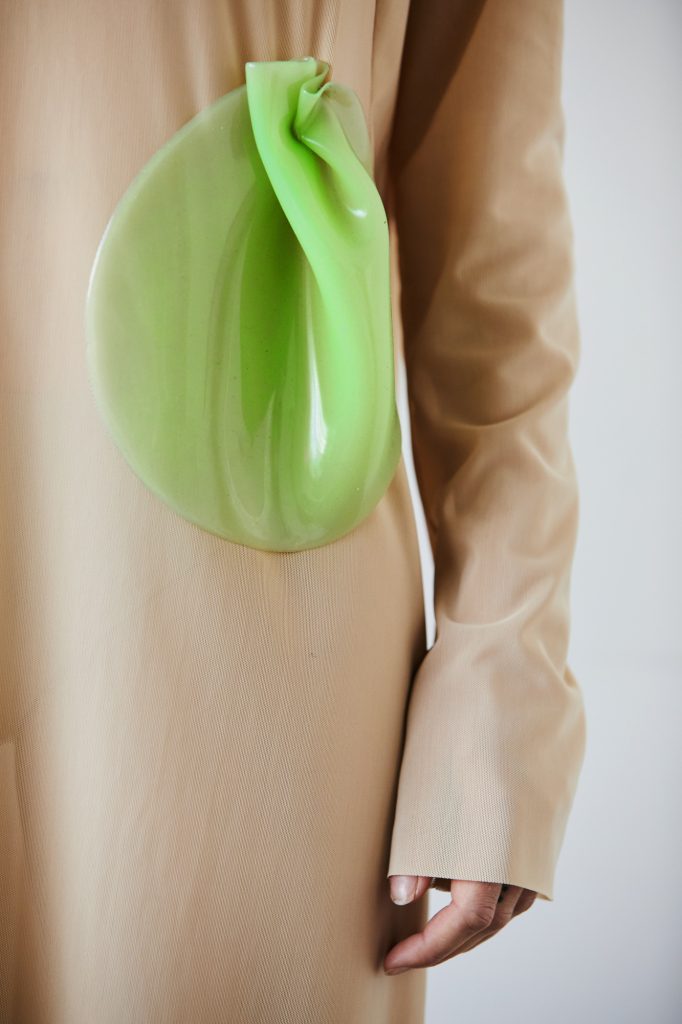
greendot
Photography by MAUDE ARSENAULT
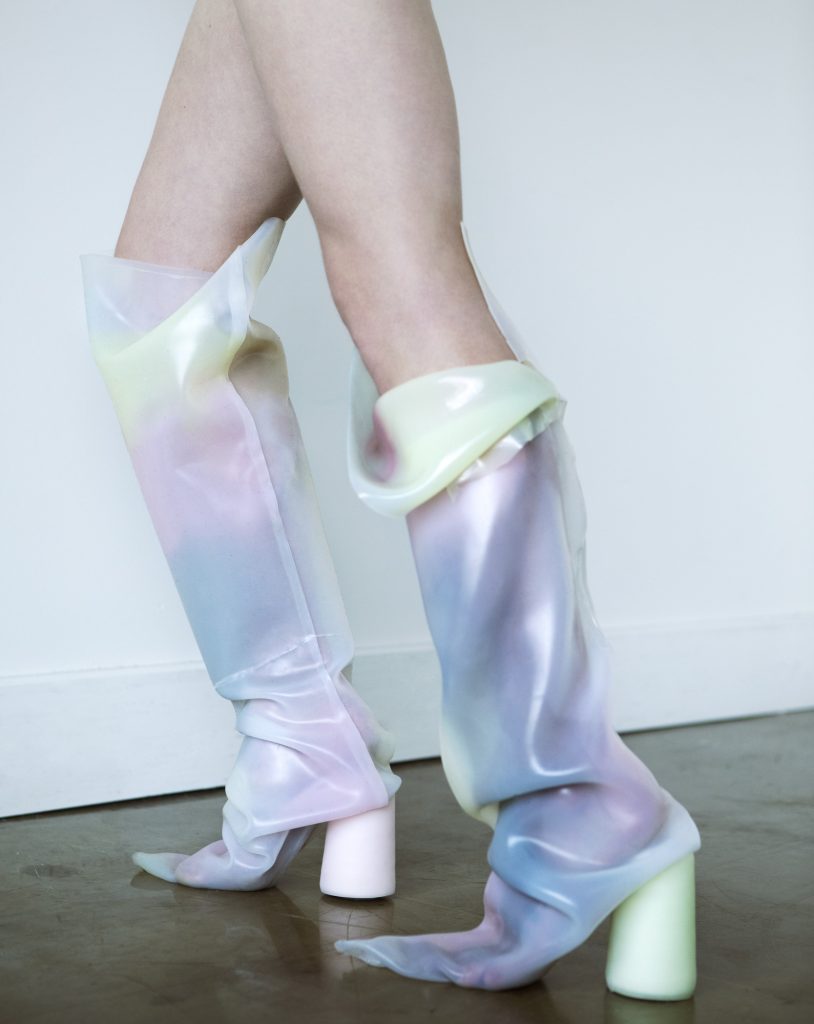
third skin
Photography by MAUDE ARSENAULT
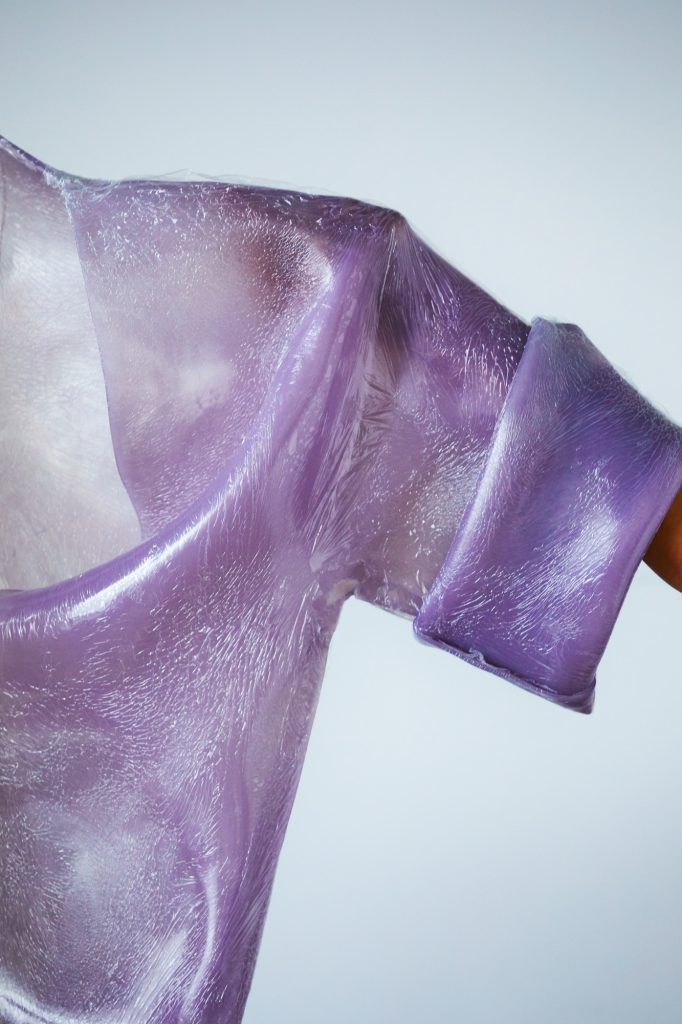
purple skin
Photography by MAUDE ARSENAULT
Photography courtesy of YING GAO
